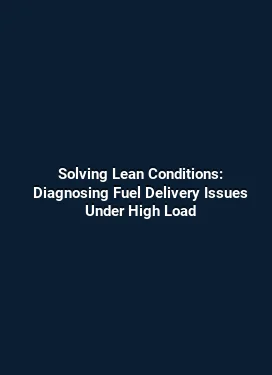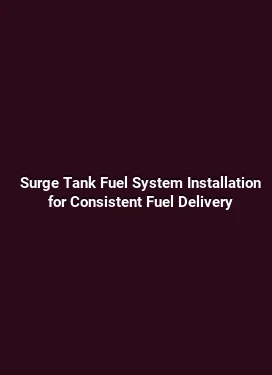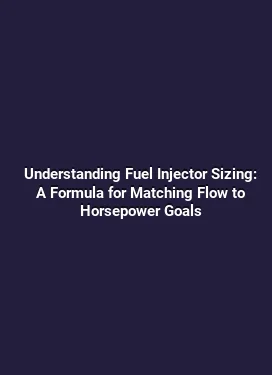Mass Air Flow Sensor vs Speed Density Tuning: A Practical Guide for Intake & Fuel Systems
In the world of internal combustion engines, achieving precise air-fuel control is essential for performance, efficiency, and reliability. Two dominant approaches to determining engine air intake are the Mass Air Flow (MAF) sensor method and the Speed Density (SD) method. Each approach has distinct advantages, limitations, and tuning workflows that influence power delivery, drivability, and long-term reliability. This guide delves into how these systems work, what differentiates them, and how to apply practical tuning strategies in real-world scenarios.
Fundamental Principles Behind Air Measurement Systems

Engine management relies on knowing how much air enters the cylinder so the ECU can calculate the correct amount of fuel to inject. Two core philosophies exist: directly measuring air mass or inferring air mass from engine speed and volumetric efficiency. The choice between these philosophies shapes sensor selection, intake tract design, and calibration procedures.
Understanding the nuances of each approach helps technicians diagnose fueling issues, select appropriate hardware, and craft robust calibration maps that respond well to changes in altitude, temperature, and engine load. The following sections break down the practical implications of each method and present a side-by-side perspective grounded in everyday tuning experiences.
Mass Air Flow (MAF) Sensor: How It Controls Air-Fuel Delivery
The MAF sensor directly measures the amount of air entering the engine. Modern hot-wire, hot-film, or vane-type sensors produce a signal proportional to air mass flow as it passes through the meter. The ECU uses this signal to immediately adjust fueling and, in many implementations, ignition timing.
In a typical MAF-based system, the sensor output is used alongside a base fueling map that assumes standard intake pressure and temperature. The dynamic range of the MAF signal can be very linear across common operating conditions, which helps with stable idle, crisp throttle response, and precise stoichiometric fueling. However, certain conditions can challenge MAF accuracy, including dirty sensors, oil contamination, or unusual intake configurations that distort airflow patterns around the sensing element.
How the sensor signal translates to fuel in practice

Engine fuel delivery must account for volumetric efficiency and air density. When the MAF reading increases, the ECU injects more fuel proportionally. When the engine is under boosted or when the intake pressure rises rapidly, the response curve must be carefully tuned to avoid over-fueling or under-fueling during transient events.
Seasoned tuners often emphasize cleanliness and protection for MAF systems: keeping the intake tract free of oil aerosols, using compatible cleaners, and ensuring the sensor is replaced if readings drift. A cracked or contaminated MAF element can produce erratic fueling, noticeable as surges or hesitation, especially at part-throttle transitions.
Common scenarios where MAF shines
- Stable, predictable airflow in normally aspirated engines.
- Applications requiring tight control during idle and light-load cruising.
- Vehicles with well-matched intake plumbing where air density variations are well understood.
Speed Density Tuning: Inferring Air Using Engine Speed and VE
Speed Density relies on measuring engine speed and estimating air mass flow through a volumetric efficiency (VE) model rather than a direct air measurement. The VE model relates engine RPM and manifold absolute pressure (MAP) or intake manifold dynamics to the amount of air the engine can draw under given conditions. The ECU then computes the required fuel to achieve the desired air-fuel ratio based on the inferred air mass.
This approach eliminates the physical sensor that measures air directly, replacing it with a calibrated map or function that represents the engine’s efficiency characteristics under various loads and temperatures. SD tuning can offer excellent performance in boosted or highly-modified engines where the intake tract shapes and sensor placement might complicate direct measurement. It also reduces potential sources of MAF-related failures and can be more cost-efficient in certain race or off-road environments.
Key factors in Speed Density calibration
SD accuracy hinges on a well-tuned VE model, accurate sensor inputs for RPM and pressure, and robust temperature compensation. Good SD tuning requires an understanding of how intake tuning, cam timing, turbo or supercharger behavior, and exhaust backpressure influence VE across the RPM range. In practice, SD maps need to reflect real-world drivability, not just peak power, to avoid abrupt transitions and fuel cuts during rapid throttle changes.
Because SD does not rely on a direct airflow signal, it can be more forgiving on certain intake designs, but it also amplifies the impact of any miscalibration. If the VE curve is mischaracterized, the engine may run rich at some loads and lean at others, leading to combustion instability or reduced performance. Proper sensor calibration, pressure transducer accuracy, and climate compensation become critical in SD setups.
Direct Comparison: Practical Implications for Tuning, Power, and Drivability
Choosing between a MAF-based system and a Speed Density approach depends on vehicle goals, hardware configuration, and the desired balance between reliability and peak performance. The practical differences often revolve around sensor reliability, ease of calibration, response to transients, and how the system behaves under modified intake or forced induction conditions.
For example, a naturally aspirated street car with a stock intake may benefit from a MAF-based setup that delivers predictable fueling with minimal recalibration. A heavily modified engine with altered VE characteristics from a cam upgrade or aftermarket intake may gain from Speed Density’s flexibility, provided the VE model is well-tuned and validated across a wide operating range.
Accuracy and sensitivity under varying conditions
MAF readings can drift with sensor contamination, temperature effects on the sensing element, and mounting orientation. SD, by contrast, relies on a robust VE map and accurate pressure/temperature inputs; if those inputs are noisy or biased, fueling accuracy can deteriorate across the RPM spectrum. In practice, MAF often offers smoother idle and light-load behavior, while SD can excel in high-load, high-boost scenarios where VE changes are pronounced and the air mass does not correlate linearly with a fixed sensor output.
Transient response and drivability
During quick throttle movements, MAF systems typically provide fast, direct feedback from the air entering the engine. SD systems must compute the proper fuel in the face of rapid changes using their VE model, which can introduce slight latency or require more sophisticated control strategies to maintain smooth transitions. For enthusiasts focusing on track performance, both methods can be tuned to minimize surge, but the tuning approach and data logging strategies differ significantly between the two.
Practical Tuning Workflows: Real-World Steps and Best Practices
Effective tuning blends empirical testing with solid physical reasoning. Below are structured workflows tailored to each approach, emphasizing practical steps, common pitfalls, and actionable tips.
MAF-based workflow
1) Inspect and prepare: Clean or replace the MAF sensor if readings are suspect. Verify that the intake tract is free of leaks and oil contaminants. Check for vacuum leaks and ensure the air filter is clean. 2) Baseline data collection: Record idle quality, part-throttle response, and steady-state wide-open-throttle (WOT) pulls on a safe, controlled dyno or track environment. Observe fuel trims and AFR stability across RPM bands.
3) Calibrate fuel tables: Start with a baseline fueling map that aligns with the stock VE assumptions. Gradually adjust fueling to maintain target air-fuel ratios under load, paying attention to transitions from idle to load and back. Use data logs to identify lean or rich pockets and refine injector scaling factors as needed.
4) Temperature and altitude compensation: Validate how readings change with ambient conditions and incorporate appropriate corrections to maintain stable fueling across the operating envelope.
5) Validation: Re-check driveability in city and highway conditions, ensuring that shifts in temperature or humidity do not destabilize AFR targets. Confirm that sensor aging or contamination does not degrade performance over time.
Speed Density workflow
1) VE map development: Build or refine a VE curve that correlates RPM and load with air mass flow. Start with a conservative, safe baseline that covers idle through mid-range power and gradually extend to high-load operation.
2) Sensor integrity: Ensure MAP/boost sensors, intake pressure sensors, and temperature sensors are accurate and responsive. SD tuning is particularly sensitive to pressure readings, so sensor health is critical.
3) Fuel model alignment: Create a fuel model that uses the inferred air mass to determine injector pulses. Validate with dyno data to ensure the AFR remains close to targets across RPM and load. Watch for lean spikes during deceleration or rapid throttle changes and stabilize with timed fuel adjustments.
4) Transient behavior: Pay close attention to throttle response and throttle tip-in. SD maps may require extra compensation during rapid acceleration to avoid hesitation or surge, especially with aggressive cam timing or forced induction setups.
5) Real-world validation: Test under varying elevations and temperatures. If the VE model doesn’t reflect actual performance, iteratively refine the map with data-driven adjustments rather than broad changes to reduce the risk of large AFR swings.
Common Pitfalls and Troubleshooting Tips
Both approaches share some challenges, but each has unique failure modes that show up in daily driving or on the dyno. Recognizing these patterns helps keep tuning efficient and reliable.
- MAF misreadings due to contamination or temperature drift can cause unexpected AFR shifts. Regular maintenance and sensor checks help prevent drift from turning into drivability issues.
- SD models that are overly simplified or not updated to reflect hardware changes (cam, turbo, exhaust) can produce mismatches between commanded and actual fueling, especially under transient loads.
- Intake system changes, including throttle body diameter, piping length, or inlet runners, affect both approaches. Re-tuning or map recalibration is often necessary after such changes.
- Dynamic events such as rapid acceleration or deceleration require careful calibration of transient fuel delivery to avoid lean bogs or rich spikes.
- Sensor aging and environmental conditions (temperature, humidity) can gradually degrade performance. Regular logging and validation help catch these trends early.
Maintenance, Upgrades, and Long-Term Considerations
When upgrading intake systems or moving to forced induction, revisiting the underlying measurement approach is essential. For some builds, a well-maintained MAF setup with a calibrated fuel map can continue to deliver excellent drivability, while for others, Speed Density with a refined VE model may unlock higher power potential and more consistent fueling under boosted conditions.
Documentation practices matter: keep a detailed log of sensor readings, calibration steps, and observed engine responses. This record becomes a valuable reference when diagnosing new issues or when repeating builds across vehicles with similar configurations.
Practical Example Scenarios
Scenario A: A naturally aspirated street car with a relatively stock intake but a mild cam upgrade. A MAF-based tuning approach can provide crisp throttle response and predictable idle, making it a favorable choice for daily driving and occasional weekend fun. The maintenance burden is relatively low, since the sensing element remains a direct measurement of airflow.
Scenario B: A heavily modified turbocharged setup with altered VE due to cam changes and altered airflow characteristics. A Speed Density approach may offer more flexibility to accommodate the altered VE across the operating range if the model is well-developed. This path often demands rigorous data collection, robust mapping, and careful validation to ensure stability during high-load operations.
Implications for Modern Engine Management and Real-World Outcomes
Across modern performance builds, both measurement philosophies contribute to reliable, predictable engine behavior when properly implemented. The decision often aligns with the vehicle’s intended use, maintenance philosophy, and the tuner’s expertise. The emphasis remains on robust data collection, careful sensor health monitoring, and a disciplined calibration workflow that prioritizes idle stability, throttle response, and efficient, safe operation under varied driving conditions.
Transitioning Between Approaches: What to Expect
Converting from a direct airflow measurement system to an inferred air mass approach or vice versa involves more than sensor swaps. It requires a comprehensive recalibration of fueling maps, VE models (if applicable), and a thorough validation process under multiple loads and environmental conditions. Expect a period of iteration as the new model converges with the engine’s real-world behavior. During this phase, data logging, controlled driving tests, and incremental adjustments are essential to achieving a stable, repeatable tune.
Advanced Considerations: Sensor Placement, Tract Design, and Data Analytics
Beyond the primary measurement philosophy, the physical design of the intake and the quality of data analytics play a significant role. Sensor placement should minimize flow disturbances and thermal influence from hot engine components. Intake tract geometry should aim for smooth, laminar flow that reduces pressure losses and avoids artificial turbulence near the sensor. In parallel, robust data analytics, including time-aligned logs of RPM, pressure, temperature, and AFR, empower more precise calibrations and faster issue resolution.
Bottom-Line Takeaways for Builders and T owners
Engine tuning that emphasizes practical performance and reliability benefits from an approach aligned with the engine’s hardware and its typical operating envelope. Whether adopting a direct measurement strategy or an inference-based method, success hinges on disciplined sensor maintenance, rigorous data-driven calibration, and continuous validation across diverse operating scenarios. Real-world testing, careful handling of transients, and meticulous map development yield the most durable improvements in power delivery and drivability.





